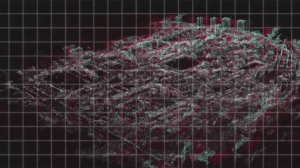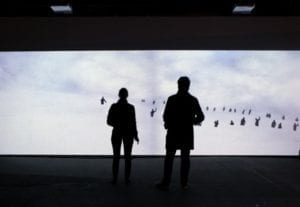Throughout my time in this class, and in light of our readings and this group project, my definition of interactivity is the communication between two actors that can receive inputs and produce outputs, so that each can respond to and influence the other. In “The Art of Interactive Design”, Crawford defines interaction “in terms of a conversation: a cyclic process in which two actors alternately listen, think, and speak (1)”. These actors, in my opinion, can include any combination and any number of people and computers.
I think this project aligns well with my definition of interactivity. Besides the programmers who created the drones to collect data, the project also employed the use of cyclists to collect data on air quality. Whereas other methods of data collection regarding air quality focus on horizontal distribution of atmospheric pollution, this project employs the use of drones to account for the vertical dimension. The main actors are the sensors that gauge air quality, the programmers, and the cyclists, and the drones. The sensors on the drones respond to the instructions of the programmer, and then they relay the data that they collect to the programmer. Likewise, the cyclists act as a sort of organic drone, transporting the sensors around the city in order to collect more data.

This project, contrarily, does not align very well with my definition because it seems to be an art installation that happens to the user. That is to say, the actions of the user do not affect their experience. To clarify, there are interactive aspects of this project, but the communication takes place between two human actors that do not physically see each other. Rather, the actions of one human actor will influence the output of the computer for the next human actor. In short, two human actors interact through the medium of the computer. To think of this project another way, Crawford posits that interactivity can and should be measured on a spectrum (6). Whether this project is interactive should not be a question of ‘yes’ or ‘no’, but rather a question of high interactivity, moderate interactivity, low interactivity, and everything in between. In my opinion, using Crawford’s approach, this particular project has low interactivity.

For the project, my group wanted to develop an idea that might be relevant one hundred years in the future. We eventually decided on one idea, a watch that would utilize sensors to collect data on the user’s heart rate and body temperature to determine the user’s mood. The watch would then communicate this determination to a computer, which would compile the user’s mood throughout the day and compose a painting using colors assigned to given moods. Additionally, the watch would record the distance and speed of the user while walking to determine the size of the brushstrokes in said painting. The actors in this interaction are the user, the watch, and the computer. The user “communicates” (through their actions rather than their words) with the watch, which then transmits these inputs to a computer that produces an output for the enjoyment of the user. In this regard, I believe our project had a moderate to high degree of interactivity.

Works Cited
Crawford, “What Exactly is Interactivity,” The Art of Interactive Design, pp. 1-5.
https://www.vice.com/en_us/article/593xxa/drones-augmented-reality-cities-map-air-pollution
‘Ghost’ installation traps visitors in an interactive snow storm